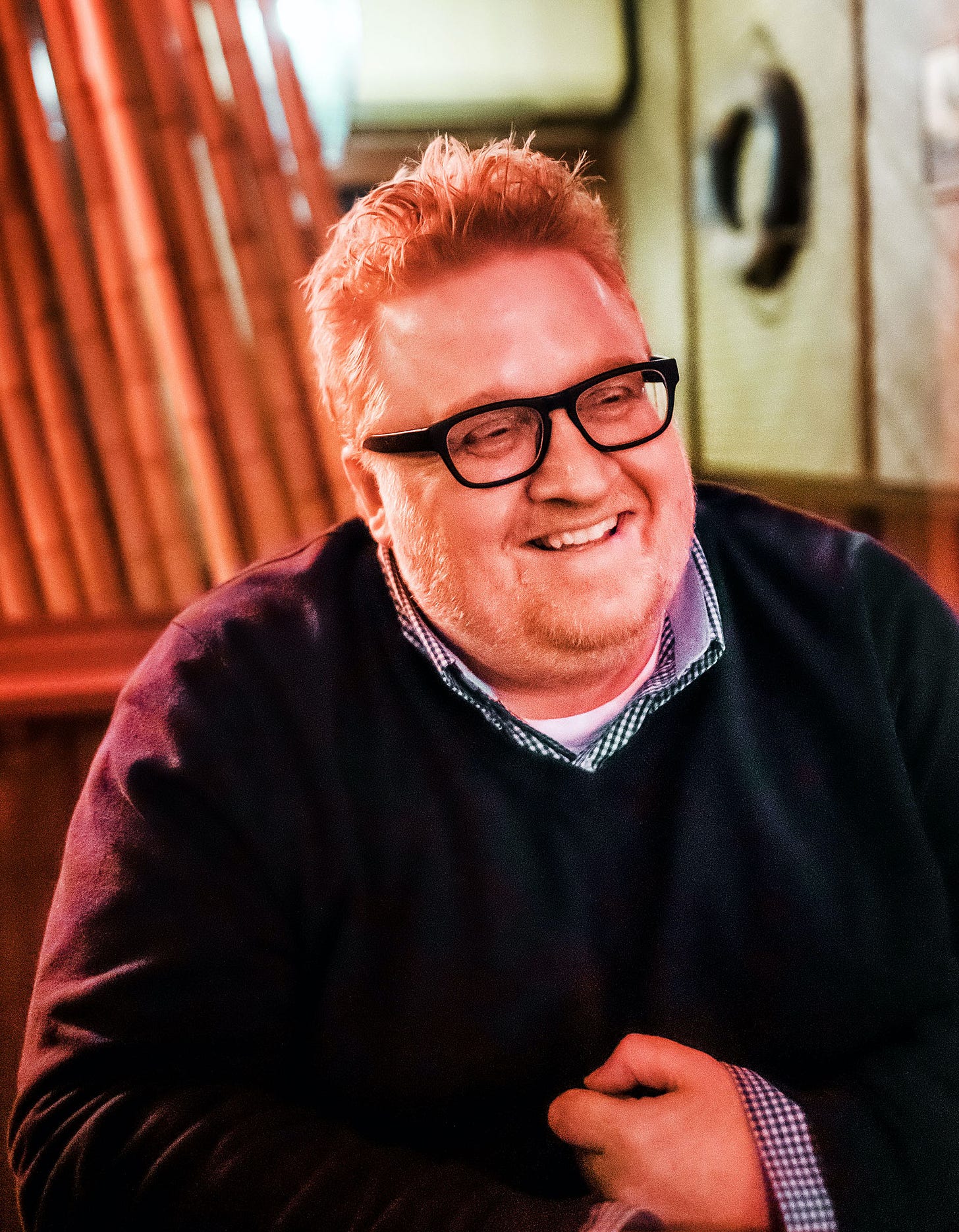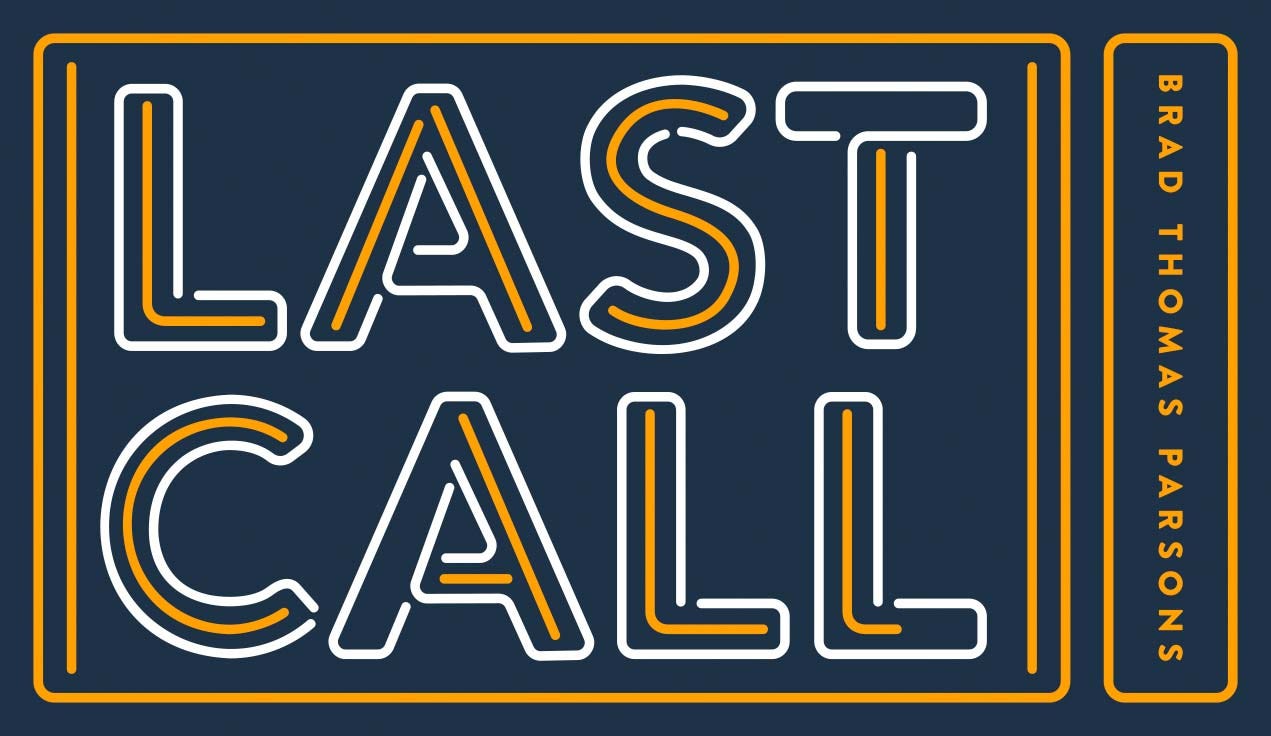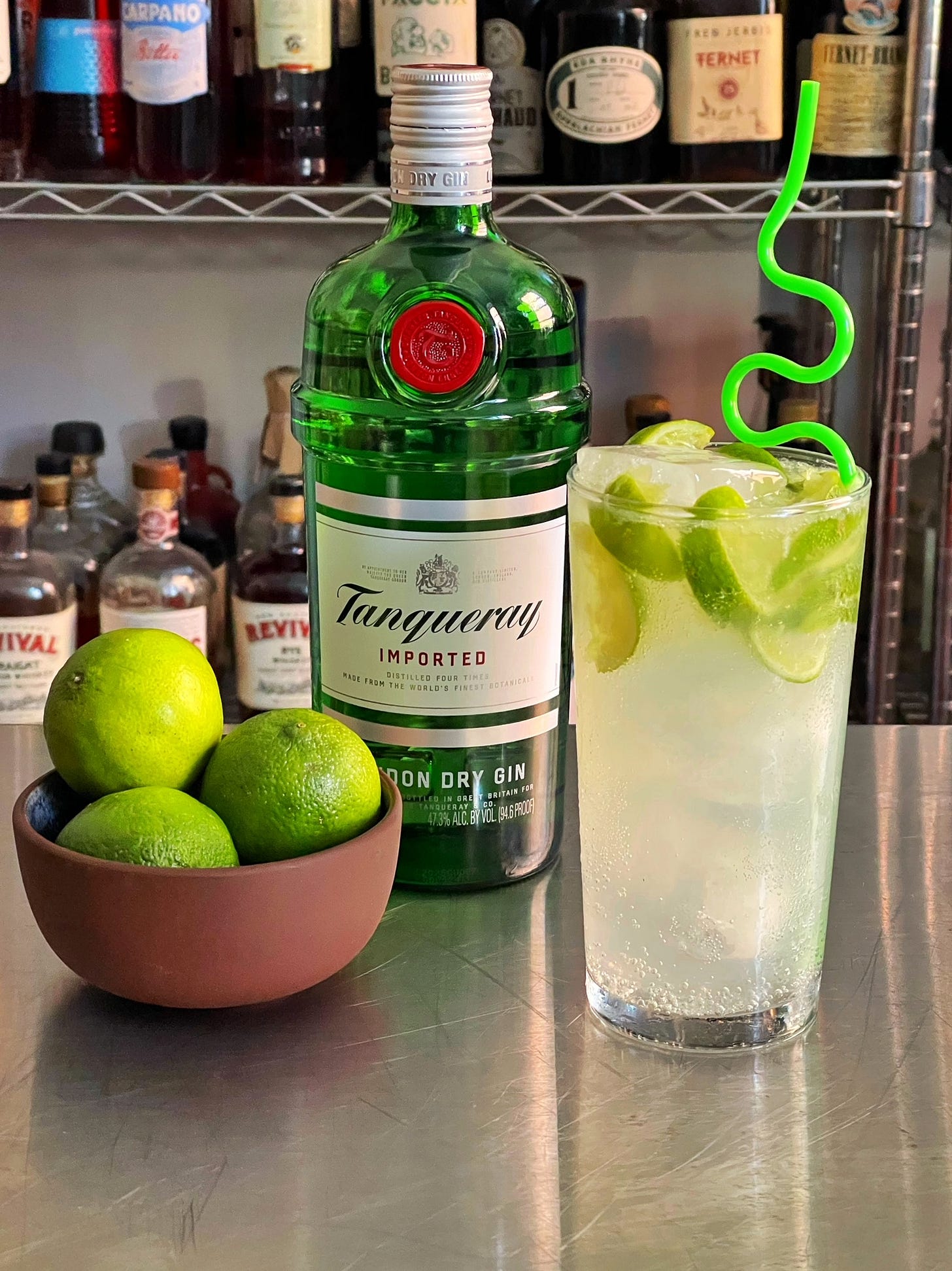Welcome to LAST CALL with Brad Thomas Parsons
“This is an adventure.” —Steve Zissou
As far back as I can remember I always wanted to be a writer. [Cue GoodFellas freeze frame and Tony Bennett’s “Rags to Riches” on the soundtrack.]
Actually, I wanted to be an actor. I studied theater in college, acquiring Bachelor of Arts degrees in English/Writing Arts and Theatre during my undergraduate years at SUNY-Oswego on the shores of mighty Lake Ontario. I tread the boards in a number of college productions (Lysistrata, Sam Shepard’s The Mad Dog Blues, A Midsummer Night’s Dream) and even directed two plays (an in-over-my-head production of David Rabe’s Hurlyburly and my own one-night-only production of Oliver’s Army, a Sgt. Pepper's-like fever-dream based on the Elvis Costello songbook). But I knew that writing was what I wanted to pursue. I felt like I’d have more control over my destiny and less rejection ahead of me than the life of an actor (I was definitely wrong about that). It just took me a while to get there.
The biography on most of the novels and short story collections I was reading at the time mentioned the author had attended an MFA writing program, so that seemed like the next step on the path to become a writer. I was accepted at the MFA Writing program at Columbia University where a number of my classmates went on to successful literary and even cinematic careers. I don’t regret that experience but I wish I had waited a few years after college to attend.
While I’ve since written four books, I still haven’t published a word of fiction. I have a one-pager and outline for an idea for a novel I keep thinking about diving into. The working title is Dough Boy and is a food-world set, High Fidelity-inspired tale of a disgraced, on his last rope food writer who returns home to a small town and ends up taking over his favorite childhood donut shop, whose owner has died. Along the way there are misadventures with a group of senior citizen regulars who hang out in the shop all day, including a former Italian-American boxing champ from the 1960s who owns the local red sauce joint. But with fiction you have to write the entire novel before you sell it to a publisher versus nonfiction, where you sell the idea via a proposal and then go out and write the actual book.
After Columbia I was pretty defeated and stumbled back home to Central New York for a few years, working as a bookseller at Borders in the local mall. I had been visiting a dear friend in Seattle since the mid-’90s and in 1999 I moved cross-country to Seattle where I eventually started working at Amazon for over a decade. As a senior editor on the books team I was finally writing, even if it was book reviews, interviews, marketing emails, and countless haiku-like promotional blurbs across the website. But I ran point on the cooking, food, and wine category, which gave me direct access to the cookbook publishing world and the chance to meet and interview chefs and writers like Anthony Bourdain, Jamie Oliver, Ruth Reichl, Ina Garten, Padma Lakshmi, Giada De Laurentiis, David Chang, Matt and Ted Lee, Bill Buford, Kenny Shopsin, and so many others, like Jon Stewart (who was my very first interview; still thrilled that I made him laugh), John Grisham, Bret Easton Ellis, Colson Whitehead, Gay Talese, Amy Sedaris, Chuck Barris, and Don Rickles.
The insane hours of the job didn’t allow much time to pursue a side hustle writing about food, but near the end of my time in Seattle I met with an editor at Seattle Met, one of the two local magazines, over drinks at The Alibi Room to pitch her a few story ideas for the food and dining section. It was 2008 and the spark of the modern cocktail revival was well underway in Seattle with bartenders like Murray Stenson, Jamie Boudreau, Andrew Bohrer, Anu Apte, Anna Wallace, Zane Harris, Jim Romdall, Andrew Friedman, and Rocky Yeh (RIP) setting the stage to make Seattle the serious cocktail city that it is today. So when the editor instead proposed I pursue writing about the cocktail scene I was game. I wrote about four 500-word monthly stories before the economy (and freelance budgets) crashed, but one of those was on the subject of bitters, which led me down a rabbit hole that I knew would be worth exploring further. A colleague of mine at Amazon was also a drinks writer and a prolific author so I suggested he should do a book about bitters. His plate was too full but he was gracious enough to suggest I take it on and introduced me to his agent.
I spent the summer researching and drafting a book proposal which resulted in selling my first book, Bitters, to Ten Speed Press. I started working on Bitters in Seattle and finished it in Brooklyn, where I moved in the summer of 2010. I was going to stay in Seattle and take my chances freelancing but instead moved back to New York to take a marketing director job in publishing (I still have Sliding Doors moments of wondering what things would be like if I didn’t leave Seattle). I always say that Seattle offered me an undergraduate degree in the world of bars and cocktails while New York was my master’s degree. Bitters was published in the fall of 2011 and went on to win an IACP Award and a James Beard Award. I even got to make drinks live on The Martha Stewart Show and was so nervous I forgot to add ice to the shaker. Bitters is now in its 16th printing with nearly 110,000 copies in print, but the biggest thrill for me remains that the book can still be found behind bars and restaurants around the world.
After Bitters was published I started writing more about cocktails and bars and spirits for magazines like Bon Appétit, Food & Wine, Travel + Leisure, and Lucky Peach, and was among one of the original contributors for PUNCH, where my work is still regularly featured. My second book, Amaro came out in 2016 and then Distillery Cats in 2017 (give @distillerycats a follow on Instagram if you’re not already). My most recent book, Last Call, was published in the fall of 2019 and after that I was working on a book about American dive bars. It took me around two years to realize that dive bars don’t give a shit about talking to writers, let alone being featured in a book. I still love visiting and writing about dives, but I’m afraid I’m not going to be the guy to write a book about them. Instead I’ve shifted gears back to all things Italy, and just started work on a new book (to be published by Ten Speed Press in the fall of 2024) exploring the customs and traditions of Italian drinking culture.
You’ll still find me writing books (maybe including that novel?) and contributing to PUNCH, VinePair, Imbibe, and other publications, but LAST CALL will give me the flexibility and creative freedom to explore other topics I’m passionate about and allow extended detours to discover new things to obsess over. Plus I’m excited to have direct engagement with my readers.
Why Subscribe?
With LAST CALL, my aim is to deliver weekly spirited dispatches on bars and bar culture, including essays and articles along with cocktail recipes, stories, interviews and profiles, behind-the-scenes first looks at my new book and projects I’m working on, and yes, all things bitter. In addition, I’ll offer insights and entertaining and informative takes on restaurants and regional foodways, popular culture, music, and sometimes cats. I hope you’ll consider subscribing and sharing LAST CALL with people who might enjoy reading it as well.
What You Will Get
Free Subscription
Monday edition of LAST CALL newsletter including essays and articles, interviews, recipes, and more.
Paid Subscription (Monthly: $5.00, Annual: $50.00)
Monday edition of LAST CALL newsletter including essays and articles, interviews, recipes, and more.
Friday edition of LAST CALL newsletter featuring Dive Bar Jukebox, a weekly exclusive where bartenders, chefs, musicians, writers, and other cool people talk about their favorite dive bars and share a hand-picked 10-song playlist.
Regular bonus special editions with subscriber-exclusive recipes, interviews, behind-the-scenes dispatches, and more.
The Annual Subscription is priced at the cost of two ice-cold Martinis and a bowl of crispy fries at your favorite cocktail bar.
Founding Member Subscription ($150.00 or more)
Receive all of the above plus a signed and personalized copy of my award-winning book, Last Call: Bartenders on Their Final Drink and the Wisdom and Rituals of Closing Time. (This book tie-in offer is currently available in US only and limited to the first 50 Founding Members.)
Now let’s have a drink to toast the occasion, shall we?
Toby Cecchini’s Gin Rickey
So far this summer my first drink when I post up at The Long Island Bar has been a Gin Rickey. They make them in the bar’s tall 20-ounce cooler glasses and the simple combination of gin, lime, and bubbly soda water results in a tart and refreshing highball that will cut through the thickest of muggy evenings (or afternoons).
As of 2011, the Rickey has been the official cocktail of Washington, DC, and the city’s Craft Bartenders Guild declared July as “Rickey Month” ever since. The Rickey’s namesake is Jospeh Kerr “Joe” Rickey (1842-1903), an honorary Colonel and Civil War veteran from Fulton, Missouri, who became an influential Democratic lobbyist in Washington, DC. His go-to drink at Shoomaker’s, a popular bar frequented by politicians (formerly located at 1331 Pennsylvania Avenue NW, where the J.W. Marriott now stands), was a bourbon and carbonated water with a squeeze of lemon juice, which he ordered at the bar in the late 1880s. Soon other patrons were asking for a “Joe Rickey” at Shoo’s (what the regulars fondly called the bar), but bartender George Williamson (1849-1915) modified the drink by using lime juice instead of lemon.
By the mid-1890s, gin became the preferred spirit base and the popularity of the Gin Rickey traveled across DC and soon the rest of the country. In The Oxford Companion to Spirits & Cocktails, DC bartender, entrepreneur, and writer Derek brown notes that by the 1900s the Rickey’s popularity was eclipsed by the scotch highball: “It never really recovered in the twentieth century, and even its modern revival has extended only fitfully beyond the borders of its hometown.”
For his version of a Gin Rickey, Toby Cecchini, the co-owner of The Long Island Bar in Cobble Hill, Brooklyn, turns to the template he perfected based on his father’s Gin & Tonic recipe, where he muddles the julienned peels from one whole lime in two to three ounces of gin. “The gin acts as a solvent to strip and incorporate the lime oil from the skins,” says Cecchini, who recommends muddling up to sixty seconds or until the gin starts to take on some of the green tint from the extracted peels (those spent peels are then used as an aromatic garnish). “It’s a tart eye-opener, this recipe—not for everyone,” says Cecchini, and he wouldn’t be offended if anyone finding the drink too “unpalatable” added an ounce of simple syrup to sweeten things up a bit.
Ingredients
2-3 ounces gin (preferably Tanqueray)
Chilled soda water or seltzer
1 lime
Directions
Cut the lime across the equator and juice each half. Reserve the juice.
Julienne each spent lime hull into thin strips.
Combine the lime strips and gin in a mixing tin and muddle for 60 seconds.
Add the reserved lime juice to the mixing tin and gently stir to incorporate.
Fill a chilled 20-ounce cooler glass (or a pint glass in a pinch) halfway with ice.
Add enough cold soda water or seltzer to fill the glass 3/4 of the way.
Strain the gin, lime juice, and lime peel mixture over the glass to carefully float the contents over the ice and soda.
Garnish with the spent lime strips and serve with a straw, giving it a stir to mix together before diving in.
Thank you for your continued support of my writing and work. I appreciate you.
—BTP
LAST CALL logo and graphics designed by Ed Anderson.




Glad to have you aboard, Brad!
What, no shoutout to the Sons of Chekhov? ;) Glad to sign up for this regular outlet for your recipes, reportage, and musing, Old Stick! I think I might make me one of these classic Gin Rickey's this very afternoon. The perfect respite from Summer's Caldron...